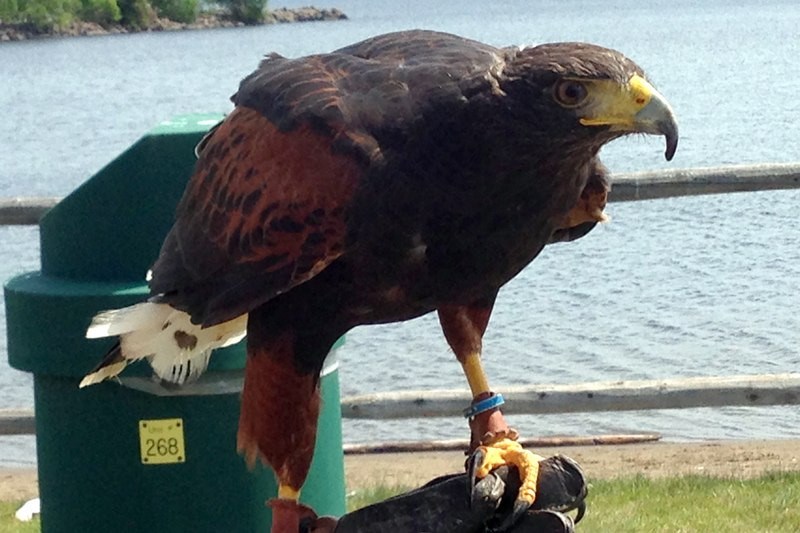Chippewa Park has gone to the birds.
Birds of prey, that is.
In an effort to scare away a flock of Canada geese whose droppings have caused unsafe bacteria levels in the waters at the Chippewa Park beach and led to its indefinite closure to swimmers, the city has turned to falconer Kym Amonson and her Harris hawk Chinook.
“We’re utilizing falconry to help control the geese down here at the beachfront,” said Amonson, the owner of Skyline Falconry, “as well as a couple of scare floaters we have installed in the open bay area as well as some pyrotechnics and things like that.”
It appears to be working, she said.
When they were first called upon in late May, there were two flocks of geese calling the inlet home, numbering about 30 birds. That number has since dwindled to about eight, and it continues to drop, Amonson said.
The key to success is randomness.
Other tactics, including predator decoys don’t always enjoy similar success rates. The geese and other pest animals might be curious at first, but soon come to realize the decoys pose no threat and aren’t hunting them.
Using a live hawk or a falcon and coming at different times of the day changes the equation.
These birds know that it’s a living, breathing predator to them. It’s not a standard decoy that just sits up and you’ll have a voice recording and it’s not moving,” Amonson said.
“It’s not chasing them. They recognize that this animal is a live and it’s chasing them. When you establish yourself there with your falconry, as well as your other means, you’re now taking over that spot as now being your territory.”
Amonson, who grew up an animal lover, was introduced to falconry later in life, and quickly fell in love with the sport, using the bird to hunt rabbits, partridge and other small game.
While the occasional goose will still try to make a home at Chippewa Park – and the seagulls appear willing to gang up when Amonson and Chinook, a three-year-old hawk, arrive at the beach – the difference is clearly notable, she said.
“The majority of the time, it’s just like this now,” she said, pointing to the deserted waters, a family of ducks floating far off in the distance.
“We’ve managed to really push them from this area. Where they’ve gone, I don’t know. But as long as they’re away from here, that’s what matters. And it seems to be working really, really well.”
In captivity, Harris Hawks have been known to live between 30 and 40 years. Amonson said Chinook doesn’t stray far, and food is used as an incentive.
She doesn’t keep the bird too hungry, but she doesn’t let it satiate itself either, to keep it motivated to continue hunting.
Chinook, who subsists mainly on a diet of day-old-chickens, does not kill the geese, but instead frightens them and convinces them to move elsewhere.
Sign in or register
- Messages
- Post a Listing
- Your Listings
- Your Profile
- Your Subscriptions
- Your Likes
- Your Business
- Support Local News
- Payment History
Registered Users
Already have an account?
New Users
Create a free account.
